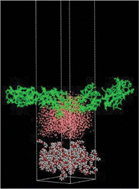Investigation of the adhesive characteristics of polymer–protein systems through molecular dynamics simulation and their relation to cell adhesion and proliferation
Abstract
Protein adhesion is a prevalent, however, intricate phenomenon that occurs immediately after exposure of a biomaterial to the biological system. A study on the adhesive characteristics of biomaterial–protein systems has encountered serious hurdles as experimental methods cannot properly capture the initial stages of protein adhesion, taking place within nano/picoseconds. This propels research studies toward utilizing computational approaches to gain an understanding of the interactions between different proteins and biomaterial surfaces. Herein, we use molecular dynamics (MD) modeling, as the computational framework, to study the adhesive characteristics of different biomaterial–protein systems. To this aim, two synthetic polymeric biomaterials, namely polycaprolactone (PCL) and polyvinyl alcohol (PVA), extensively used in tissue engineering are included. Four protein fragments are also considered including two extracellular matrix (ECM) proteins: collagen type-I, and fibronectin, along with two subdomains of human serum albumin (HSA). Subsequently, the adhesive characteristics of these polymer–protein systems were quantified by calculating the work of adhesion and peeling force through MD simulations. In the next phase of the study, cell proliferation and adhesion using bone marrow cells on electrospun scaffolds composed of PCL and PVA nanofibers were investigated to gain an understanding of the connection between the protein adhesion characteristics obtained from the simulations and cell adhesion and proliferation from an experimental assay. The results indicate that generally the hydrophobic surface of PCL represents both stronger protein adhesion and better cell proliferation. However, the PVA surface represents better adhesion only for one albumin subdomain. Results of this study demonstrate a direct connection between the stronger adhesion of ECM proteins to the biomaterial surface and more desirable cell adhesion and proliferation.


 Please wait while we load your content...
Please wait while we load your content...